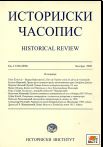Скитски разбојници у бугарској пустињи: поглед једног ходочасника на Поморавље средином XI века
Scythian Brigands in Bulgarian Desert: A Pilgrim’s View of Great Morava Valley in Mid 11th Century
Author(s): Aleksandar UzelacSubject(s): History
Published by: Istorijski institut, Beograd
Keywords: Raoul of Saint-Sepulchre; Lietbert of Cambrai; Great Morava Valley; Pechenegs; 11th Century
Summary/Abstract: Bishop Lietbert of Cambrai, who went to the Holy Land in 1054, was one of the earliest western pilgrims who traversed Medieval Balkans. He followed the route already known to his contemporaries and compatriots - through Hungary and then along Via Militaris into the interior of the Peninsula. One of his companions was monk Raoul (Rоdulphus) of Saint-Sepulchre of Cambrai, who almost half a century later wrote report of the pilgrimage, preserved on the pages of Lietbert’s Vita. It is of primary importance as an eyewitness description of the district proverbially known as Bulgarian desert (modern Great Morava Valley). Radul of St. Sepulchre depicted it as a wooded wilderness, inhabited only by Scythian brigands (Pechenegs) who led nomadic way of life without permanent settlements and who were always on the move with their properties and families. In addition, he described their appearance, weapons and military skills, including their use of camels as riding animals. He also indirectly provided clues for understanding the presence of islamic religion among the Pechenegs, which have had only superficial influence upon the nomads and their traditional society. Moreover, in comparison with other written and archeological sources, his report enables us to outline the subsequent gradual process of sedentarization and integration of newcomers into local socio-political and military structures. Despite his apparent disinterest in local geography, the report is trustworthy source that casts much needed light on a nomadic society transplanted from the Lower Danube to the Balkan hinterlands; society that played an important role in local history, but has not left many traces of its existence.
Journal: Историјски часопис
- Issue Year: 2010
- Issue No: 59
- Page Range: 59-76
- Page Count: 17
- Language: Serbian

